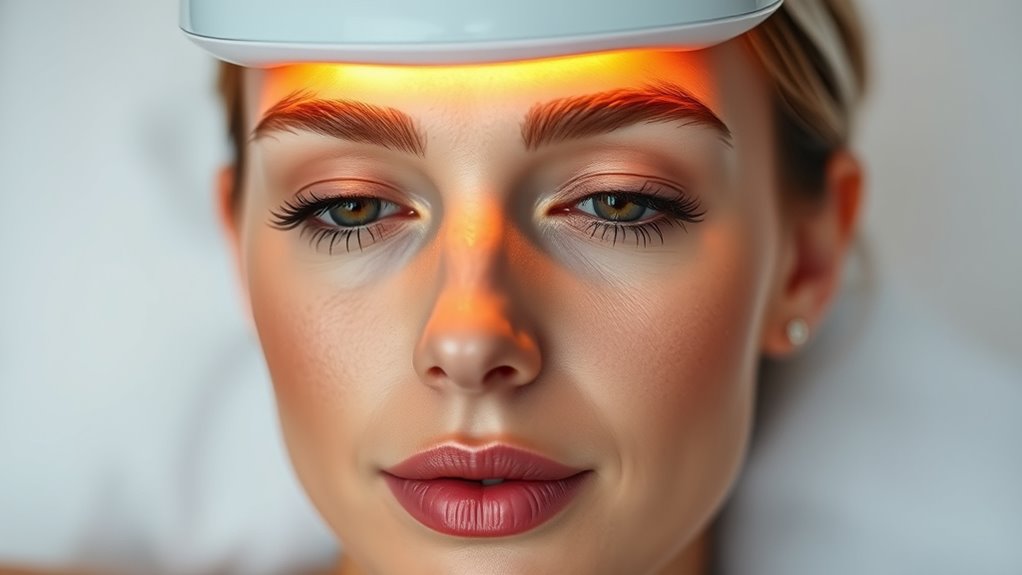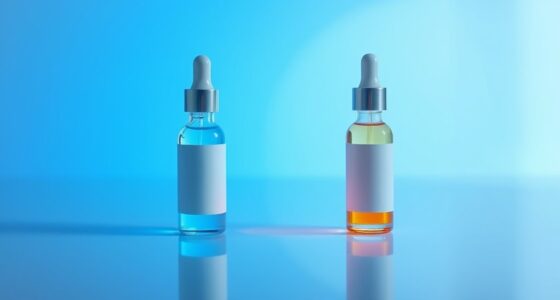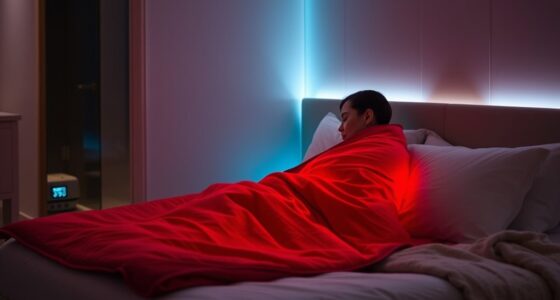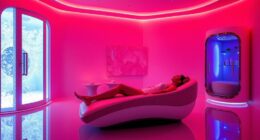After waxing or threading, light therapy helps soothe your skin, reduce redness, and speed up healing. Using devices with red or infrared light penetrates deeply, stimulating cell repair and calming inflammation. Make sure your skin is clean before application, follow the instructions carefully, and stay consistent. This gentle treatment boosts blood flow and prevents ingrown hairs, leaving your skin calmer and smoother faster. Keep exploring to discover more tips for ideal skin recovery.
Key Takeaways
- Use red or infrared light therapy devices to soothe skin, reduce redness, and speed healing after waxing or threading.
- Ensure skin is clean and free of products before applying light therapy for optimal results.
- Follow device instructions on duration and distance to safely promote skin recovery.
- Light therapy decreases inflammation, swelling, and discomfort, helping prevent ingrown hairs.
- Combine with gentle skincare and sun protection to enhance healing and maintain healthy skin post-treatment.
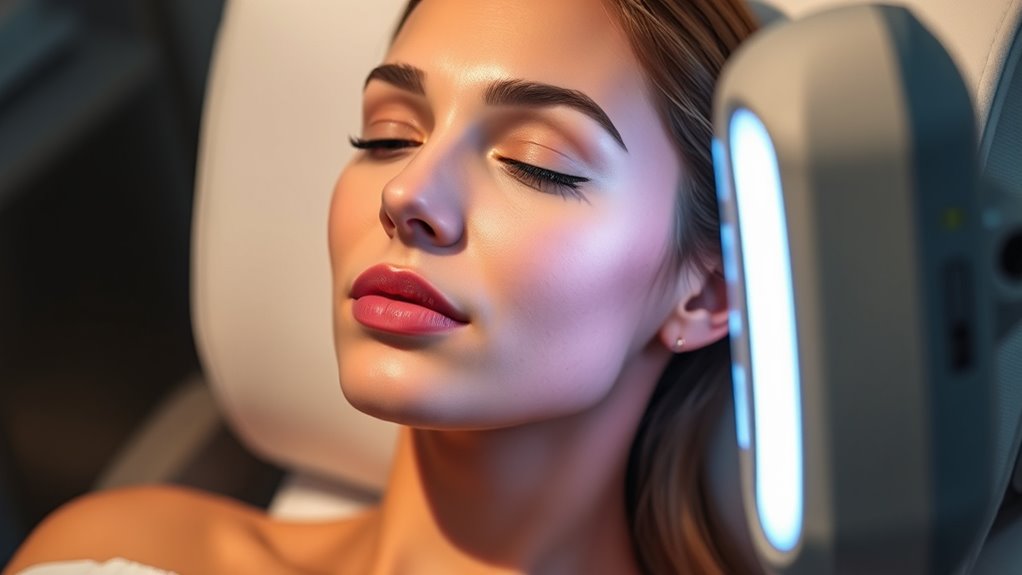
After waxing or threading, your skin can become sensitive, red, and prone to irritation. This is a common reaction as your skin recovers from the hair removal process. It’s important to give your skin the proper care it needs during this time to prevent further issues like ingrown hairs or inflammation. One effective way to soothe your skin and promote healing is light therapy. Light therapy uses specific wavelengths of light to reduce redness, calm inflammation, and accelerate skin recovery. When used correctly after waxing or threading, it can make a noticeable difference in how your skin feels and looks.
You should start by choosing the right type of light therapy device. Many devices use red or infrared light, which penetrate deeply into the skin and stimulate cellular repair. These wavelengths are gentle and safe, making them ideal for sensitive post-treatment skin. Before applying the light therapy, ensure your skin is clean and free of lotions, oils, or makeup. This helps the light penetrate more effectively and reduces the risk of irritation. Follow the manufacturer’s instructions carefully, as each device might have different recommended durations and distances for maximum results.
Using light therapy after waxing or threading can help reduce redness and swelling more quickly. The light promotes increased blood flow, which speeds up the removal of waste products and delivers essential nutrients to your skin cells. This process can considerably lessen the discomfort that often accompanies sensitive skin after hair removal. Additionally, light therapy can help prevent ingrown hairs by calming the skin and reducing inflammation that causes hairs to grow inward. Incorporating lifestyle practices such as proper skincare routines can further enhance healing. Regular sessions, especially during the first few days after waxing or threading, can make your skin feel calmer and look smoother faster.
It’s also important to incorporate light therapy into a gentle skincare routine. Use soothing products like aloe vera or hyaluronic acid afterward to maximize calming effects. Avoid harsh scrubs, alcohol-based toners, or strong chemical treatments for a few days post-treatment. Protect your skin from sun exposure by applying a broad-spectrum sunscreen, as your skin may be more vulnerable to UV damage during this period. Consistency is key—using light therapy daily or every other day as recommended can speed up healing and improve your overall skin condition.
Frequently Asked Questions
Can Light Therapy Cause Skin Pigmentation Changes?
Yes, light therapy can cause skin pigmentation changes, especially if your skin is sensitive or if you don’t follow proper precautions. You might notice darkening or lightening of the treated area, which usually resolves over time. To minimize risks, make certain you consult a professional, follow their instructions carefully, and avoid sun exposure before and after treatment. This helps protect your skin and ensures the best results.
How Long Should I Wait After Waxing Before Starting Light Therapy?
Think of your skin as a freshly tilled garden bed. You should wait at least 24 to 48 hours after waxing before starting light therapy. This pause allows any redness or irritation to settle, just as soil needs time to settle before planting. Rushing in too soon risks aggravating your skin, so give it a day or two to recover fully, ensuring safe and effective light therapy sessions.
Is Light Therapy Suitable for All Skin Types Post-Threading?
Light therapy can be suitable for most skin types after threading, but you should proceed with caution. If you have sensitive, dark, or recently irritated skin, consult a dermatologist first. It’s crucial to wait until your skin calms down and any redness or irritation subsides. Always perform a patch test and follow your provider’s recommendations to minimize risks and ensure the therapy benefits your skin without causing adverse effects.
Are There Any Side Effects Specific to Facial Light Therapy?
Think of facial light therapy as a gentle sunbeam for your skin—yet, even the softest light can cast shadows. You might experience temporary redness, mild irritation, or a tingling sensation. Rarely, some may develop small bumps or dryness. It’s like a delicate dance—if you notice persistent discomfort or unusual reactions, it’s wise to consult your skincare professional to keep your skin glowing without unwanted surprises.
How Often Should Light Therapy Sessions Be Scheduled After Waxing?
You should schedule light therapy sessions 24 to 48 hours after waxing. This allows your skin to recover and reduces the risk of irritation. Typically, once or twice a week is recommended, but it’s best to follow your skincare professional’s advice. Avoid overdoing it to prevent redness or sensitivity. Always listen to your skin’s response and adjust the frequency if you notice any discomfort.
Conclusion
After waxing or threading, embracing light therapy can soothe your skin, reduce redness, and promote healing. It calms inflammation, restores balance, and enhances your glow. By incorporating light therapy into your post-treatment routine, you nurture your skin, protect your skin, and elevate your confidence. With consistent care, you support your skin’s recovery, boost your radiance, and enjoy lasting smoothness. Ultimately, light therapy offers a gentle, effective way to care for your skin after hair removal, empowering you to feel your best.
